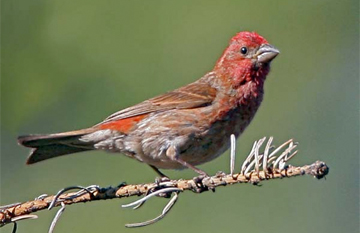Nearly 60 percent of the 305 species found in North America in winter have shifted their ranges northward by an average of 35 miles, according to an assessment by the Audubon Society.
The findings are based on 40 years of data from the group’s Christmas Bird Count — an effort that enlists citizens in a massive bird census each year — and suggest “that global warming is having a serious impact on natural systems.” Over the past 40 years the average January temperature in the United States increased by about 5°F (2.8°C).
“Northward movement was detected among species of every type, including more than 70 percent of highly adaptable forest and feeder birds,” said the Audubon Society in a statement.
 Purple Finch: A frequent visitor to bird feeders, this colorful bird, which is frequently confused with the more common House Finch, is an “irruptive species,” meaning that it winters far to the south in some winters and farther north in others. As temperatures have increased in recent years, however, the birds have not gone as far south during their irruptions – resulting in overall northward movement of over 433 miles in the last 40 years. Text and image courtesy of the Audobon Society. |
One species, the purple finch, is now wintering 433 miles farther north than it did 40 years ago. The wild turkey has expanded its range 408 miles northward.
“Birds are among the most adaptable of wildlife – as long as they can find suitable habitat, they are able to travel substantial distances north, inland, or to higher latitudes. That is one of the things that makes them sensitive environmental indicators – alerting us to ecological disruption, often before it directly affects us,” said the group.
“Audubon’s new analysis reveals that many species that winter in the U.S. are moving significantly north – strong evidence that global warming is already altering their – and our – environment.”
The analysis found that some birds, including the bulk of grassland species, are not following the trend, despite rising temperatures climb.
“For these species disappearing habitat is taking an enormous toll and leaving them with nowhere to go – even as climate change is altering what habitat remains.”














